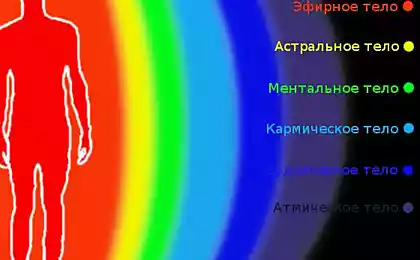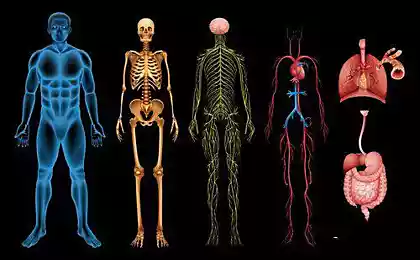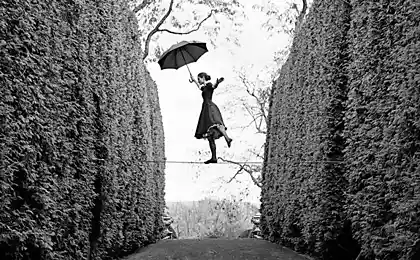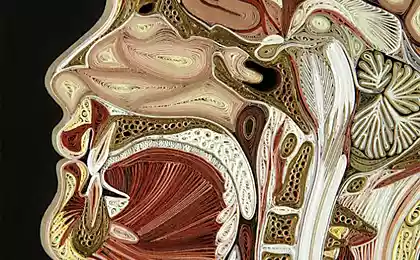654
Hidden memory — body memory
Most people do not remember themselves in early childhood. However, these experiences are deeply etched in personal memory and life effect on physical self-perception, relationships with others and the ability to cope with psychological problems. Therefore, the first years of life is the most important period of development of the psyche.
Any of You remember how a year old fell out of bed and scared parents? Or what kind of lullabies sung at night mother? As it tossed in the hands of the father? Probably not. Usually people consciously remember being around the age of four. But all that has happened before, only know from the words of loved ones. But that early childhood experiences leave a deep mark in the memory of a lifetime.
In the ordinary sense of the word "remember" means "to know." Man remembers the first day of school, the familiar faces, phone numbers. This memory science called explicit (explicit.) It is the actual information stored in the cerebral cortex of the brain, which can be reproduced in consciousness and to Express in words. She allows you to go back to the past, to learn from it and use them to predict future events.
Twelve million one hundred fifteen thousand three hundred twenty
But many things people do instinctively: to tie your shoelaces pedal bike to find in the dark switch... Algorithm of these actions is also stored in memory. The exact reaction experienced goalkeeper, the ability to navigate in space, useful (and harmful) habits — everything is a memory. Don't just store memories, it is literally woven from them. Although not aware of this.
This memory is called implicit — hidden. Stored in it does not realize its difficult to describe. Her medium is the body itself. German philosopher and psychiatrist Thomas Fuchs calls it "body memory".
This bodily experience of the past in which the person unconsciously guided in life. Some of these skills are practiced to perfection, through conscious efforts, which then become unconscious. For example, someone who often works at the computer, can't reproduce from memory the layout of the letters on the keyboard. But his fingers already do "know" where to click. And musicians and athletes coordination is so complex that consciousness it is better not to intervene. It's too slow.
However, there is an experience which originally acquired without consciousness. For example, everyone knows that hugs are calming. And can be identified by tone of voice the mood of the interlocutor.
As a rule, consciousness is "switched on" only at the moment when there is some "anomaly" that violates the usual course of things. When a person makes a "typo". Feel pain or anxiety. Or notices that behaves irrationally, but can't understand their feelings. For example, when a squeal of brakes suddenly awakens throughout the body a tangible memory of them experienced in the distant past a car accident.
Neurophysiology has long been focused on the study of the phenomenon of consciousness. And only recently found out what a tremendous influence the bodily experience of emotions and thinking. First of all the unconscious memories of the first years of life, when a person understands the science of communication with other people is not at the level of words and intellect and with touch and feelings.
Infancy — the most important stage of mental development. Largely depends on how the child will grow — fearful or strong, insecure or confident. And most importantly, how will he behave with other people.
Bodily memories — it's like a foreign language. His study of imitation — that is, actions where all experiences boil down to physical sensations.
"Draw the face of despair," asks Beatrice Beebe, psychoanalyst and Professor at Columbia University (USA). Remains frowned and curled his mouth as if about to collapse. In response, the Bib turns away. Although it's just a game, her gesture clearly reads: leave me alone. Then she turns with a smile. But is it comforting?
Then she looks up with a sneer as if to say: stop whining, it's not so bad! Inevitably begin to feel resentment. Now her face a neutral expression.
She clearly does not notice someone else's plea for help. From facial expressions have to go to the words: "Help!"After that, she also portrays the face of despair and sympathetic groans in response. And only in this moment do you feel that you understand.
Beatrice Beebe is studying non-verbal communication between child and mother. Its purpose is to determine when two people cannot understand each other without words and when not. Main the object of her research is children aged from four months to one year.
It largely determines the period. For the first year of life, the brain volume of the baby doubles at the ninth month reaches the peak of the formation of new neural connections. Especially in rapidly developing parts of the brain responsible for regulating stress and emotion analysis. And of neuronal contacts (synapses) in the brain of the baby is formed almost twice more than necessary.
Synapses operate on the principle of "use it or lose it", says Michael Merzenich, one of the leading neuroscientists from the University of California. Depending on the conditions in which a child grows, some neural connections are used intensively, while others "sleep" and eventually "off". So the brain adapts to the reality in which to exist.
The main incentive for the development of the brain serve as contacts with relatives, primarily with the mother. At this point, its main task — impress upon the child the sense of security and alleviate stress acting as a mediator between him and the outside world.
Research material Beatrice Beebe — video communication between mother and child. When filming using two cameras. For everyone—. Then the frames per second are analyzed. Only under such a "microscope" can be traced to unconscious signals: gestures, facial expressions, touch, tone. And determine how mother and baby interact with each other and how between them there is mutual understanding and emotional connection.
Today — the era of industrialization. Modern parents try to accustom their children to a separate room, forgetting that man is a "social being." And this property manifests itself even before birth.
Observing the behavior of twins in the womb, Italian researchers found that after 14 weeks the embryos make purposeful movement towards each other. And in the first hour after birth, newborns begin to imitate movements and facial expressions of others. And this is not surprising. After all, successful communication with others — the key to survival.
Parents often laugh in the faces of the child, when he begins to imitate their facial expressions: pulls his lips or shows the tongue. But for scientists is a serious fact: newborns are already watching what a person does in their field of vision. Infants are projecting what they saw on their bodily sensations. And know how to capture a likeness. But it is the beginnings of a critical ability to understand others and mentally put yourself in his place.
This is a real revolution in neurophysiology. If earlier it was thought that many brain functions are not connected with the outside world, it's now clear: the brain is a "contact body".
Scene on video: four-month-old boy looks at his mother. She makes exaggerated surprised face. He raises an eyebrow, slightly opens her legs and spreads his fingers. The mother smiles. Both shake their heads and exchange smiles. The child looks up, scowling. Mother touches him on the arm. He relaxes.
Their body language is so rich in undertones that all the nuances are impossible to convey in words.
Experiments show that when one person repeats the expressions and gestures of the other, adopts the same posture or adjusts to the rhythm of his steps, this enhances the feeling of emotional closeness. And during the intimate conversation, both interlocutors even synchronized rhythms of the brain. And there is an ability to predict other people's words.
One of the rules of effective communication: the partner must behave so that the other could for a few seconds ahead to predict his actions and your reaction, says Bib. Already in three-four months children begin to calculate the possible consequences of their actions on the principle "if I do this, it will happen-so." For example, if I look at mother, she will smile and I will be happy. If I scream, it is me Pat and I calm down.
Children learn that any expression of emotions has an impact on the other person and themselves. Learn about yourself and gain the recognition of others.
It would seem, are striving for adults, not babies. But in fact, "self-knowledge and confession" is not so much a goal, as the fundamental principle of psychological well-being. The ability to understand themselves and to communicate with others is vital regardless of age.
The child begins to comprehend the "science of relationships" with infants. Know how to Express their feelings, to attract attention. How to behave with others. What kind of help you can expect in a stressful situation. Later formed in childhood behavior patterns are repeated in friendships and romantic relationships. In dealing with my own children. In such cases, say: "You're acting like your mother."
And judging by the results of long-term studies, so it is.
Joy, fear, anger — the ability to Express all these feelings not given birth. It's learn. And not always successfully. Unbelievable but true: a lot of people suffer from alexithymia — the inability to process my emotions and understand what others feel. Such people are unable to distinguish between internal irritation from stomach disorders, psychological discomfort from physical ailments. And all because they have almost no aktiviziruyutsya a part of the brain responsible for translating bodily sensations into emotions.
In extreme cases, even physical dulled sensitivity. The body simply does not react to emotional stimuli: sadness, joy, anger. This condition is reminiscent of emotional paralysis. But alexithymia is not a disease, but merely a psychological defense mechanism against the unbearable fear, aggression or boredom. And it is formed usually in the early childhood years.
What happens?
Children are born only with a set of primitive signals and expression of primary emotions: dissatisfaction, pleasure, fear and concern. At first they serve for the child than some sort of sensors the condition of the body. If the internal balance is disturbed, the body sounds the alarm. And the child cries out, informing an adult. "The expression of emotions is a way of communication that allows to achieve a desired reaction from another person", — says an expert on emotional development Manfred Holodinsky from münster University (Germany).
Emotions — it's an incentive to restore inner balance. And for someone who has them, and in order to whom they are addressed.
But at first the ways of expressing emotions in a child are so similar, that the parents are difficult to guess whether he cries from hunger, from pain or just from boredom. Adults respond to the cries of the baby exaggerated facial expressions. Thanks to it the child gradually realizes, as they Express the feelings he's experiencing. For example, anger. Or fear. Scared the child's parents are usually "play up" only a few moments. If you long to show him that I say, too afraid, to reassure it will not happen.
Gradually the child learns to Express their emotions more accurately. And, guided experience, links them with certain feelings. In his bodily memory is accumulated knowledge base of emotional and physical reactions. He begins to understand what a pleasure. To be proud of. And what need to be ashamed of.
Both positive and negative emotional "install" it takes parents. Imbued with fear of the outside world — under the influence of a hypochondriac mother. Or aversion to snails — by the example of his father. And all this is delayed in physical memory at such a young age, which further defies comprehension.
At first, the children Express their feelings literally all body. With only two years of age they begin to master the powerful new tools of communication — speech.
And learn to Express emotions in words, not just actions. And internally to distance themselves from the experiences. "Instead of trying to identify with some feeling, they begin to realize that just experiencing it," explains Manfred Holodinsky.
Language gives the child a key to his inner world. But without the help of parents to get there he can't. Guidance to provide their questions: "Why are you crying? What happened to you?"The only way he can understand what feelings are hidden behind the external reactions such as tears. Later in life it helps him to analyze and control their emotions.
Listening to your inner voice, the child learns to perceive and correctly interpret even the weakest signals that the body takes in response to new emotional stimuli: "creepy", stomach cramps, muscle tension or dry mouth. The American neuroscientist Antonio Damasio calls these reactions «somatic markers". They serve to consciousness prompts when making decisions.
"I think therefore I exist", — once said Descartes. Damasio paraphrased his formula: "I feel therefore I exist".
Body memory stores much more information than the conscious mind.
During one test, ten-year-olds are unable to read at the photos of his grown up friends at the kindergarten. But judging by the galvanic skin response, they remembered. Increased arousal in these studies is the change in electrical resistance of the skin. Famous case: two-year-old child who has been in a year old to violence, unable to recognise in the photo of the offender, but the photo caused him physical stress.
The deepest scars of emotional memory the result of the most painful experiences. They serve as a warning for the future. But sometimes emotional trauma is so strong that the mind is not able to cope with it. The horror just does not fit in the mind as a cohesive whole.
This experience is stored only in implicit memory in the form of separate impressions. Any such detail — familiar smell, sound, gesture, fatal date — instantly resurrects the seemingly long-forgotten past. To protect against unbearable memories about every third victim resorts to the so-called "dissociation": unconsciously "splits" the traumatic memory into incoherent fragments. And then, they're not perceived as real.
Beatrice Beebe is enough to watch a few minute video recording of behavior four months, to predict future psychological problems — at least eight months, at least for twenty years.
Typical episode: the baby whimpers piteously, and his mother, not paying attention to it, with a smile tugging on his leg. He tries to Dodge. But she doesn't notice his defensive reactions. And, still smiling, leans in to him. He presses his head into his shoulders and stretches out his hands. She approaches it closely.
The scene produces a feeling of revulsion. "This woman does not understand her child, says Bib. Usually these mothers are too insecure or suffer from depression. Or do you want them to have a perfect, ever-smiling child. And so ignoring his other emotions."
Such communication not only drives the child to the stress, but desorientiert it. It reproduces the contradictory emotional signals of the mother confuses the conflicting forms of expression of emotions — smile and tears. Mother calls to him and at the same time repels. "So start a future mental disorder," says Beebe.
Even adults to have some little understanding of words. Want interlocutor filed confirming signs: nodding, raised eyebrows, assented. And four children, the adult is removed from one who violates his personal space. And instantly notices the shifty eyes or laugh inappropriately.
But if this happens not occasionally, but constantly — and in communication with the closest person? It is easy to imagine how it affects a small child. He can't take care of himself. Can't go on. Mom — the only person he knows in the whole world. And without her he can't calm down.
At this age the child is still not familiar unconscious ploy by which adults independently relieve excitement: erochat his hair, rubbing the nose or chin.Touch act as a sedative. And help reduce stress. This confirms the results of encephalographic studies carried out recently by Martin Grunwald, a specialist in tactile perception from Leipzig (Germany).
The lack of tactile contact leaves gaps in the physical memory of the child. Touch is the first sense of the person. It develops in the womb. And for a long time remained the main. Thanks to feeling, grasping and touching, the child determines personal "boundaries" and gets an idea of your body. The tactile contact gives him a sense of confidence and security. Stimulate the production of growth hormones. Inhibit the release of stress hormones. Normalize heart rhythm, respiration and blood pressure. The beneficial effects of touch, feel and adults. But not all.
"Ten percent of our patients can not tolerate touch, says Peter Joreski, a specialist in psychosomatics of Dresden. Often they feel disgust for their own body. It is usually related to lack of tactile contact in childhood. Perhaps they had a notorious mother who avoided touching. Or their child too severely squeezed, the long disregarded".
Decades later, they are experiencing the same emotional contrasts in intimate relationships. In severe cases, the aversion to touch moves to a subconscious rejection of your own body. Because of this, in the period of puberty may develop anorexia — weight loss mania, accompanied by nausea and vomiting.
Early experiences shape the developing psyche of the child. It looks like the gardener pruning the branches of saplings to give the future a tree of the desired shape. If the child is not sure that he in time will change a diaper or comforted in the arms, it grows in conditions of constant stress. And the body won't forget it. He will be excitable, impulsive, ready for instant domestic mobilization. A constant voltage is costly for the psyche. Leaves less room for pleasant emotions. Stress hormones inhibit the formation of synapses and neural connections. Hence the development of those parts of the brain that are responsible for the control of inner impulses and the perception of signals from the body.
"Negative childhood experience does not disappear. Often it is imprinted in the psyche for a lifetime, says the American physician Vincent Felitti. — Time does not heal the psychological trauma of the first years of life. It merely preserves it. We just think that we forgot them. But the body remembers everything."
University town of Cambridge near Boston (USA). From the subway exit, the best students of the country. And on the square in front of the station "hanging out" is very different young people: the homeless, alcoholics, drug addicts. A sad contrast to... Why one cannot reach their full potential, while others sink to the bottom, have not really begun to live?
All the losers have something in common: almost 70 percent of patients, American psychiatrists complain of a rough childhood. Among the prisoners there are almost 100 percent.
And this is just the tip of the iceberg. The magnitude of the problem opened in 1995 after the medical institutions of the USA performed a unique study of "adverse childhood experiences". The survey involved more than 17 thousand people. A third of respondents admitted that the child was beaten.
20 percent complained of sexual harassment. Almost every fourth among immediate family was an alcoholic. One in five is mentally ill. Every eighth child had witnessed fights and quarrels between the parents.
This list goes on. The researchers found a direct relationship: the more positive answers the Respondent gives to the questions on negative childhood experiences, the higher the probability that at maturity he will suffer depression, obesity, alcoholism, drug addiction, cardiovascular disease, cancer or diabetes. Only six such adverse factors reduce life for 20 years.
When unpleasant experiences develop into mental trauma? What happens at each stage of the development of neural connections? Scientists get more accurate answers to these questions. Already installed: reliable emotional support in the first two years of life serves to shield the child from traumatic experiences — even when innate propensity for stress.
If a child is exposed to family physical or moral violence, the result may be a "bouquet" of violations. That's why many professionals require to officially recognize the disease "trauma and development".
"Children with this diagnosis need on a physical level to learn to control their emotions," says Bessel van der colque, a Professor of psychiatry and organizer of the center for psychological trauma in Boston. He was one of the first to realize that a person's body "remembers" trauma. And created for their patients teenage drama Studio. And for children there is a special playroom.
There is a carousel, balls, trampoline. And everywhere thick mats. The perfect Playground for nervous, depressed, Moody and emotionally pinched kids. Here they can retrieve the missing bodily experience: to relax, to "make friends" with your own body.
A boy of seven with a cry throws the dolls into the wall, not reacting to persuasion. Therapist Elizabeth Warner offers him jump on the trampoline with her. In the same rhythm. There is a contact. The shackles dropped. The child is changing before our eyes: laughing, talking without hesitation.
Elizabeth Warner, Director of the project, watching such miraculous transformations constantly. Especially sandwiched some kids literally have to awaken from the "emotional hibernation".
Secret Warner the ability to balance the level of excitation of the nervous system of the child. The only way he can "return to his body", to understand their feelings, learn to control them. And assimilate new experience. In this case, she was able to reassure seven-year-old patient due to the distractions of physical activity — jumping on the trampoline.
Now the boy falls to the floor and demands that she clocked him with a ball in the face. This is no accident — one day dad poked his nose in dirty diapers and slapped blows; since the child does not touch my face while washing. The therapist initially hesitates. But nothing to do. She throws the ball. He beats his forehead. Once again. He dodges it. Beats his hands and feet. Mother calls to join the game.
All of this is Sigmund Freud described a century ago — people suffering from trauma, again and again reproduce on a physical level, painful experiences, repressed from conscious memory. Often, they are doomed to repeat this life. Victims of violence often find their outlet in the role of abuser. And thereby convey the traumatic experience further — their children. But this seven year old boy unconsciously tries to escape from the vicious circle. To associate the unbearable past with new experiences.
"As soon as the child begins to feel a reliable connection with another person, he is trying to change: quit the role of passive victims. And be an active partner," says Elizabeth Warner.
It turns out that the body is not only memory, but also a tool of self-development. Not only in children but also in adults. The only problem is that adults in the reception the therapist is not moving, and sitting in a chair or lie on a couch. And talk, talk, talk...
They are trying to find the words to describe their fears. Irrational actions. Childhood experience. Until finally not comprehend these facts and do not lay them "on the shelves" in conscious memory.
But this does not absolve from the burden of the past: the body continues subconsciously to remember the experience. And the past returns again and again — as physical reactions. "To reprogram the physical memory to re-experience old emotions in a safe environment and learn to perceive them in a new way," says Bessel van der colque.
How to act in difficult situations the child? Would call a Creek mother. Asked to be on hand. Slam the door. Wept.
Baby's emotional cues as a stimulus to others. And an adult for himself. The release of adrenaline, increased heartbeat and breathing, muscle tension, loss of appetite — all this is not that other, as the call to action.
And enter new experiences in the memory of the body. published
Author: INES, Pessemier
P. S. And remember, only by changing their consumption — together we change the world! ©
Join us in Facebook , Vkontakte, Odnoklassniki
Source: www.geo.ru/nauka/pamyat-tela?page=0#article-body
Any of You remember how a year old fell out of bed and scared parents? Or what kind of lullabies sung at night mother? As it tossed in the hands of the father? Probably not. Usually people consciously remember being around the age of four. But all that has happened before, only know from the words of loved ones. But that early childhood experiences leave a deep mark in the memory of a lifetime.
In the ordinary sense of the word "remember" means "to know." Man remembers the first day of school, the familiar faces, phone numbers. This memory science called explicit (explicit.) It is the actual information stored in the cerebral cortex of the brain, which can be reproduced in consciousness and to Express in words. She allows you to go back to the past, to learn from it and use them to predict future events.
Twelve million one hundred fifteen thousand three hundred twenty
But many things people do instinctively: to tie your shoelaces pedal bike to find in the dark switch... Algorithm of these actions is also stored in memory. The exact reaction experienced goalkeeper, the ability to navigate in space, useful (and harmful) habits — everything is a memory. Don't just store memories, it is literally woven from them. Although not aware of this.
This memory is called implicit — hidden. Stored in it does not realize its difficult to describe. Her medium is the body itself. German philosopher and psychiatrist Thomas Fuchs calls it "body memory".
This bodily experience of the past in which the person unconsciously guided in life. Some of these skills are practiced to perfection, through conscious efforts, which then become unconscious. For example, someone who often works at the computer, can't reproduce from memory the layout of the letters on the keyboard. But his fingers already do "know" where to click. And musicians and athletes coordination is so complex that consciousness it is better not to intervene. It's too slow.
However, there is an experience which originally acquired without consciousness. For example, everyone knows that hugs are calming. And can be identified by tone of voice the mood of the interlocutor.
As a rule, consciousness is "switched on" only at the moment when there is some "anomaly" that violates the usual course of things. When a person makes a "typo". Feel pain or anxiety. Or notices that behaves irrationally, but can't understand their feelings. For example, when a squeal of brakes suddenly awakens throughout the body a tangible memory of them experienced in the distant past a car accident.
Neurophysiology has long been focused on the study of the phenomenon of consciousness. And only recently found out what a tremendous influence the bodily experience of emotions and thinking. First of all the unconscious memories of the first years of life, when a person understands the science of communication with other people is not at the level of words and intellect and with touch and feelings.
Infancy — the most important stage of mental development. Largely depends on how the child will grow — fearful or strong, insecure or confident. And most importantly, how will he behave with other people.
Bodily memories — it's like a foreign language. His study of imitation — that is, actions where all experiences boil down to physical sensations.
"Draw the face of despair," asks Beatrice Beebe, psychoanalyst and Professor at Columbia University (USA). Remains frowned and curled his mouth as if about to collapse. In response, the Bib turns away. Although it's just a game, her gesture clearly reads: leave me alone. Then she turns with a smile. But is it comforting?
Then she looks up with a sneer as if to say: stop whining, it's not so bad! Inevitably begin to feel resentment. Now her face a neutral expression.
She clearly does not notice someone else's plea for help. From facial expressions have to go to the words: "Help!"After that, she also portrays the face of despair and sympathetic groans in response. And only in this moment do you feel that you understand.
Beatrice Beebe is studying non-verbal communication between child and mother. Its purpose is to determine when two people cannot understand each other without words and when not. Main the object of her research is children aged from four months to one year.
It largely determines the period. For the first year of life, the brain volume of the baby doubles at the ninth month reaches the peak of the formation of new neural connections. Especially in rapidly developing parts of the brain responsible for regulating stress and emotion analysis. And of neuronal contacts (synapses) in the brain of the baby is formed almost twice more than necessary.
Synapses operate on the principle of "use it or lose it", says Michael Merzenich, one of the leading neuroscientists from the University of California. Depending on the conditions in which a child grows, some neural connections are used intensively, while others "sleep" and eventually "off". So the brain adapts to the reality in which to exist.
The main incentive for the development of the brain serve as contacts with relatives, primarily with the mother. At this point, its main task — impress upon the child the sense of security and alleviate stress acting as a mediator between him and the outside world.
Research material Beatrice Beebe — video communication between mother and child. When filming using two cameras. For everyone—. Then the frames per second are analyzed. Only under such a "microscope" can be traced to unconscious signals: gestures, facial expressions, touch, tone. And determine how mother and baby interact with each other and how between them there is mutual understanding and emotional connection.
Today — the era of industrialization. Modern parents try to accustom their children to a separate room, forgetting that man is a "social being." And this property manifests itself even before birth.
Observing the behavior of twins in the womb, Italian researchers found that after 14 weeks the embryos make purposeful movement towards each other. And in the first hour after birth, newborns begin to imitate movements and facial expressions of others. And this is not surprising. After all, successful communication with others — the key to survival.
Parents often laugh in the faces of the child, when he begins to imitate their facial expressions: pulls his lips or shows the tongue. But for scientists is a serious fact: newborns are already watching what a person does in their field of vision. Infants are projecting what they saw on their bodily sensations. And know how to capture a likeness. But it is the beginnings of a critical ability to understand others and mentally put yourself in his place.
This is a real revolution in neurophysiology. If earlier it was thought that many brain functions are not connected with the outside world, it's now clear: the brain is a "contact body".
Scene on video: four-month-old boy looks at his mother. She makes exaggerated surprised face. He raises an eyebrow, slightly opens her legs and spreads his fingers. The mother smiles. Both shake their heads and exchange smiles. The child looks up, scowling. Mother touches him on the arm. He relaxes.
Their body language is so rich in undertones that all the nuances are impossible to convey in words.
Experiments show that when one person repeats the expressions and gestures of the other, adopts the same posture or adjusts to the rhythm of his steps, this enhances the feeling of emotional closeness. And during the intimate conversation, both interlocutors even synchronized rhythms of the brain. And there is an ability to predict other people's words.
One of the rules of effective communication: the partner must behave so that the other could for a few seconds ahead to predict his actions and your reaction, says Bib. Already in three-four months children begin to calculate the possible consequences of their actions on the principle "if I do this, it will happen-so." For example, if I look at mother, she will smile and I will be happy. If I scream, it is me Pat and I calm down.
Children learn that any expression of emotions has an impact on the other person and themselves. Learn about yourself and gain the recognition of others.
It would seem, are striving for adults, not babies. But in fact, "self-knowledge and confession" is not so much a goal, as the fundamental principle of psychological well-being. The ability to understand themselves and to communicate with others is vital regardless of age.
The child begins to comprehend the "science of relationships" with infants. Know how to Express their feelings, to attract attention. How to behave with others. What kind of help you can expect in a stressful situation. Later formed in childhood behavior patterns are repeated in friendships and romantic relationships. In dealing with my own children. In such cases, say: "You're acting like your mother."
And judging by the results of long-term studies, so it is.
Joy, fear, anger — the ability to Express all these feelings not given birth. It's learn. And not always successfully. Unbelievable but true: a lot of people suffer from alexithymia — the inability to process my emotions and understand what others feel. Such people are unable to distinguish between internal irritation from stomach disorders, psychological discomfort from physical ailments. And all because they have almost no aktiviziruyutsya a part of the brain responsible for translating bodily sensations into emotions.
In extreme cases, even physical dulled sensitivity. The body simply does not react to emotional stimuli: sadness, joy, anger. This condition is reminiscent of emotional paralysis. But alexithymia is not a disease, but merely a psychological defense mechanism against the unbearable fear, aggression or boredom. And it is formed usually in the early childhood years.
What happens?
Children are born only with a set of primitive signals and expression of primary emotions: dissatisfaction, pleasure, fear and concern. At first they serve for the child than some sort of sensors the condition of the body. If the internal balance is disturbed, the body sounds the alarm. And the child cries out, informing an adult. "The expression of emotions is a way of communication that allows to achieve a desired reaction from another person", — says an expert on emotional development Manfred Holodinsky from münster University (Germany).
Emotions — it's an incentive to restore inner balance. And for someone who has them, and in order to whom they are addressed.
But at first the ways of expressing emotions in a child are so similar, that the parents are difficult to guess whether he cries from hunger, from pain or just from boredom. Adults respond to the cries of the baby exaggerated facial expressions. Thanks to it the child gradually realizes, as they Express the feelings he's experiencing. For example, anger. Or fear. Scared the child's parents are usually "play up" only a few moments. If you long to show him that I say, too afraid, to reassure it will not happen.
Gradually the child learns to Express their emotions more accurately. And, guided experience, links them with certain feelings. In his bodily memory is accumulated knowledge base of emotional and physical reactions. He begins to understand what a pleasure. To be proud of. And what need to be ashamed of.
Both positive and negative emotional "install" it takes parents. Imbued with fear of the outside world — under the influence of a hypochondriac mother. Or aversion to snails — by the example of his father. And all this is delayed in physical memory at such a young age, which further defies comprehension.
At first, the children Express their feelings literally all body. With only two years of age they begin to master the powerful new tools of communication — speech.
And learn to Express emotions in words, not just actions. And internally to distance themselves from the experiences. "Instead of trying to identify with some feeling, they begin to realize that just experiencing it," explains Manfred Holodinsky.
Language gives the child a key to his inner world. But without the help of parents to get there he can't. Guidance to provide their questions: "Why are you crying? What happened to you?"The only way he can understand what feelings are hidden behind the external reactions such as tears. Later in life it helps him to analyze and control their emotions.
Listening to your inner voice, the child learns to perceive and correctly interpret even the weakest signals that the body takes in response to new emotional stimuli: "creepy", stomach cramps, muscle tension or dry mouth. The American neuroscientist Antonio Damasio calls these reactions «somatic markers". They serve to consciousness prompts when making decisions.
"I think therefore I exist", — once said Descartes. Damasio paraphrased his formula: "I feel therefore I exist".
Body memory stores much more information than the conscious mind.
During one test, ten-year-olds are unable to read at the photos of his grown up friends at the kindergarten. But judging by the galvanic skin response, they remembered. Increased arousal in these studies is the change in electrical resistance of the skin. Famous case: two-year-old child who has been in a year old to violence, unable to recognise in the photo of the offender, but the photo caused him physical stress.
The deepest scars of emotional memory the result of the most painful experiences. They serve as a warning for the future. But sometimes emotional trauma is so strong that the mind is not able to cope with it. The horror just does not fit in the mind as a cohesive whole.
This experience is stored only in implicit memory in the form of separate impressions. Any such detail — familiar smell, sound, gesture, fatal date — instantly resurrects the seemingly long-forgotten past. To protect against unbearable memories about every third victim resorts to the so-called "dissociation": unconsciously "splits" the traumatic memory into incoherent fragments. And then, they're not perceived as real.
Beatrice Beebe is enough to watch a few minute video recording of behavior four months, to predict future psychological problems — at least eight months, at least for twenty years.
Typical episode: the baby whimpers piteously, and his mother, not paying attention to it, with a smile tugging on his leg. He tries to Dodge. But she doesn't notice his defensive reactions. And, still smiling, leans in to him. He presses his head into his shoulders and stretches out his hands. She approaches it closely.
The scene produces a feeling of revulsion. "This woman does not understand her child, says Bib. Usually these mothers are too insecure or suffer from depression. Or do you want them to have a perfect, ever-smiling child. And so ignoring his other emotions."
Such communication not only drives the child to the stress, but desorientiert it. It reproduces the contradictory emotional signals of the mother confuses the conflicting forms of expression of emotions — smile and tears. Mother calls to him and at the same time repels. "So start a future mental disorder," says Beebe.
Even adults to have some little understanding of words. Want interlocutor filed confirming signs: nodding, raised eyebrows, assented. And four children, the adult is removed from one who violates his personal space. And instantly notices the shifty eyes or laugh inappropriately.
But if this happens not occasionally, but constantly — and in communication with the closest person? It is easy to imagine how it affects a small child. He can't take care of himself. Can't go on. Mom — the only person he knows in the whole world. And without her he can't calm down.
At this age the child is still not familiar unconscious ploy by which adults independently relieve excitement: erochat his hair, rubbing the nose or chin.Touch act as a sedative. And help reduce stress. This confirms the results of encephalographic studies carried out recently by Martin Grunwald, a specialist in tactile perception from Leipzig (Germany).
The lack of tactile contact leaves gaps in the physical memory of the child. Touch is the first sense of the person. It develops in the womb. And for a long time remained the main. Thanks to feeling, grasping and touching, the child determines personal "boundaries" and gets an idea of your body. The tactile contact gives him a sense of confidence and security. Stimulate the production of growth hormones. Inhibit the release of stress hormones. Normalize heart rhythm, respiration and blood pressure. The beneficial effects of touch, feel and adults. But not all.
"Ten percent of our patients can not tolerate touch, says Peter Joreski, a specialist in psychosomatics of Dresden. Often they feel disgust for their own body. It is usually related to lack of tactile contact in childhood. Perhaps they had a notorious mother who avoided touching. Or their child too severely squeezed, the long disregarded".
Decades later, they are experiencing the same emotional contrasts in intimate relationships. In severe cases, the aversion to touch moves to a subconscious rejection of your own body. Because of this, in the period of puberty may develop anorexia — weight loss mania, accompanied by nausea and vomiting.
Early experiences shape the developing psyche of the child. It looks like the gardener pruning the branches of saplings to give the future a tree of the desired shape. If the child is not sure that he in time will change a diaper or comforted in the arms, it grows in conditions of constant stress. And the body won't forget it. He will be excitable, impulsive, ready for instant domestic mobilization. A constant voltage is costly for the psyche. Leaves less room for pleasant emotions. Stress hormones inhibit the formation of synapses and neural connections. Hence the development of those parts of the brain that are responsible for the control of inner impulses and the perception of signals from the body.
"Negative childhood experience does not disappear. Often it is imprinted in the psyche for a lifetime, says the American physician Vincent Felitti. — Time does not heal the psychological trauma of the first years of life. It merely preserves it. We just think that we forgot them. But the body remembers everything."
University town of Cambridge near Boston (USA). From the subway exit, the best students of the country. And on the square in front of the station "hanging out" is very different young people: the homeless, alcoholics, drug addicts. A sad contrast to... Why one cannot reach their full potential, while others sink to the bottom, have not really begun to live?
All the losers have something in common: almost 70 percent of patients, American psychiatrists complain of a rough childhood. Among the prisoners there are almost 100 percent.
And this is just the tip of the iceberg. The magnitude of the problem opened in 1995 after the medical institutions of the USA performed a unique study of "adverse childhood experiences". The survey involved more than 17 thousand people. A third of respondents admitted that the child was beaten.
20 percent complained of sexual harassment. Almost every fourth among immediate family was an alcoholic. One in five is mentally ill. Every eighth child had witnessed fights and quarrels between the parents.
This list goes on. The researchers found a direct relationship: the more positive answers the Respondent gives to the questions on negative childhood experiences, the higher the probability that at maturity he will suffer depression, obesity, alcoholism, drug addiction, cardiovascular disease, cancer or diabetes. Only six such adverse factors reduce life for 20 years.
When unpleasant experiences develop into mental trauma? What happens at each stage of the development of neural connections? Scientists get more accurate answers to these questions. Already installed: reliable emotional support in the first two years of life serves to shield the child from traumatic experiences — even when innate propensity for stress.
If a child is exposed to family physical or moral violence, the result may be a "bouquet" of violations. That's why many professionals require to officially recognize the disease "trauma and development".
"Children with this diagnosis need on a physical level to learn to control their emotions," says Bessel van der colque, a Professor of psychiatry and organizer of the center for psychological trauma in Boston. He was one of the first to realize that a person's body "remembers" trauma. And created for their patients teenage drama Studio. And for children there is a special playroom.
There is a carousel, balls, trampoline. And everywhere thick mats. The perfect Playground for nervous, depressed, Moody and emotionally pinched kids. Here they can retrieve the missing bodily experience: to relax, to "make friends" with your own body.
A boy of seven with a cry throws the dolls into the wall, not reacting to persuasion. Therapist Elizabeth Warner offers him jump on the trampoline with her. In the same rhythm. There is a contact. The shackles dropped. The child is changing before our eyes: laughing, talking without hesitation.
Elizabeth Warner, Director of the project, watching such miraculous transformations constantly. Especially sandwiched some kids literally have to awaken from the "emotional hibernation".
Secret Warner the ability to balance the level of excitation of the nervous system of the child. The only way he can "return to his body", to understand their feelings, learn to control them. And assimilate new experience. In this case, she was able to reassure seven-year-old patient due to the distractions of physical activity — jumping on the trampoline.
Now the boy falls to the floor and demands that she clocked him with a ball in the face. This is no accident — one day dad poked his nose in dirty diapers and slapped blows; since the child does not touch my face while washing. The therapist initially hesitates. But nothing to do. She throws the ball. He beats his forehead. Once again. He dodges it. Beats his hands and feet. Mother calls to join the game.
All of this is Sigmund Freud described a century ago — people suffering from trauma, again and again reproduce on a physical level, painful experiences, repressed from conscious memory. Often, they are doomed to repeat this life. Victims of violence often find their outlet in the role of abuser. And thereby convey the traumatic experience further — their children. But this seven year old boy unconsciously tries to escape from the vicious circle. To associate the unbearable past with new experiences.
"As soon as the child begins to feel a reliable connection with another person, he is trying to change: quit the role of passive victims. And be an active partner," says Elizabeth Warner.
It turns out that the body is not only memory, but also a tool of self-development. Not only in children but also in adults. The only problem is that adults in the reception the therapist is not moving, and sitting in a chair or lie on a couch. And talk, talk, talk...
They are trying to find the words to describe their fears. Irrational actions. Childhood experience. Until finally not comprehend these facts and do not lay them "on the shelves" in conscious memory.
But this does not absolve from the burden of the past: the body continues subconsciously to remember the experience. And the past returns again and again — as physical reactions. "To reprogram the physical memory to re-experience old emotions in a safe environment and learn to perceive them in a new way," says Bessel van der colque.
How to act in difficult situations the child? Would call a Creek mother. Asked to be on hand. Slam the door. Wept.
Baby's emotional cues as a stimulus to others. And an adult for himself. The release of adrenaline, increased heartbeat and breathing, muscle tension, loss of appetite — all this is not that other, as the call to action.
And enter new experiences in the memory of the body. published
Author: INES, Pessemier
P. S. And remember, only by changing their consumption — together we change the world! ©
Join us in Facebook , Vkontakte, Odnoklassniki
Source: www.geo.ru/nauka/pamyat-tela?page=0#article-body























